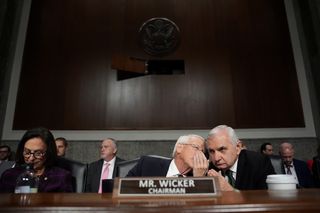Last month, J.D. Vance paid a visit to my old hometown of Erie, Pennsylvania – population 270,000 – an industrial county in the rustbelt.
Vance held a rally at a trucking warehouse before stopping by my old butcher – Gordon’s Meat Market – for a beer and roast beef sandwich.
Democratic vice presidental nominee Tim Walz wasn’t far behind him, visiting a week later. At a lake-side park where my kids used to ride their bikes, the congenial Walz gave a heartland pitch and also delivered a prophecy: “It is very possible and most likely probable the road to the White House will go through this park in Erie.”
Pennsylvania is ground zero for the Trump and Harris campaigns. This week, Donald Trump told a rally in the state, “if we win Pennsylvania, we win the whole thing”.
Trump knows he has no chance of winning liberal states such as New York or California; Kamala Harris is equally out of luck in conservative strongholds like Texas and Mississippi. That leaves swing states such as Georgia, Michigan, Wisconsin and Pennsylvania up for grabs.
With its 19 Electoral College votes, Pennsylvania is the biggest prize of the total 270 votes needed to eke out a victory. As Walz and Trump both acknowledge, the road to the White House not only runs through Pennsylvania, but through Erie – a swing county in a swing state.
In 2008 and 2012, Erie County went for Barack Obama, before flipping to Donald Trump in 2016, and then back to the Democrats with Joe Biden in 2020 – foretelling the nation’s election result for four straight election cycles.
In the 11 years I spent living in Erie, I was astonished by the level of political activity around election time. In 2016 alone, the city had visits from Bernie Sanders, Bill Clinton, Tim Kaine, and a packed rally for Donald Trump.
As an old, blue-collar, industrial city, Erie represents a microcosm of the diversity of the state. Alongside its abandoned factories, the city is home to a Fortune 400 company, Erie Insurance, regional hospitals and colleges, and a fast-growing refugee population, with recent arrivals from Syria and Afghanistan. Past the city limits, you hit farmland and properties emblazoned with Trump signs.
While Harris’ ground game in Pennsylvania will be to run up the vote in urban centres like Philadelphia and Pittsburgh – targeting women, university-educated voters and black and minority voters – she also needs places like Erie.
With Walz in her pocket, Harris will try to claw back the white working-class voters – especially men – who historically voted Democrat but flipped for Trump in 2016. These voters are long aggrieved by a belief that trade deals like the North American Free Trade Agreement – a Bill Clinton-engineered pact that removed most tariffs on products and services passing between the US, Canada, and Mexico – destroyed their communities. Trump tapped into the pain of these voters with his “America First” protectionist pitch.
Whether Walz and Harris can enthuse working-class voters remains an open question. The decision by a powerful national union, the International Brotherhood of Teamsters, to withhold its endorsement this election cycle portends the challenge ahead for the Harris-Walz ticket. With 1.3 million members – including everyone from truck drivers to warehouse workers – the transportation union has consistently backed Democratic candidates for nearly 30 years. In making its decision, the union released internal polling showing majority support for Trump among its membership.
While Trump has courted the vote of working Americans, he is also going after other historically Democratic constituencies. In Pennsylvania, this includes Hispanic communities which have grown as the demographics shifted in places like Lancaster and Allentown. At a rally in Johnstown on 30 August, Trump invited Puerto Rican rapper Anuel AA on stage: Anuel AA documented the event to his 38 million followers on Instagram wearing a MAGA hat.
With polling averages showing Trump and Harris neck and neck in Pennsylvania, it will come down to the razor’s edge. In 2016, Trump won the state by only 44,000 votes, while in 2020, Biden won it by 80,000. If history is any indication, a crowd size that wouldn’t fill the MCG may determine the next president of the United States. To see which way that crowd is moving, keep your eyes on Erie County.









